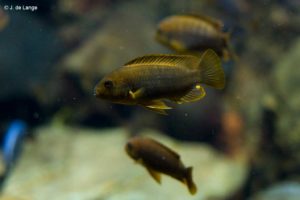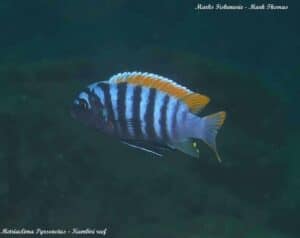Pseudotropheus cyaneorhabdos – Maingano
Pseudotropheus cyaneorhabdos was previously called Melanochromis maingano, after the island of Maingano. This is a small island off the coast of Likoma island. They occur exclusively on a stretch of rocky coast to the northeast of Likoma Island from Mbako Point to Membe and are most common around Maingano Island. The catchy name describes what this species looks like. Melano means black and chromis means fish, cyaneo means blue and rhabdos means striped. Due to its limited distribution, this species is not present in large numbers. Stuart Grant has captured a number of them and provided larger quantities of captive bred animals on site. Exporting wild-caught fish is only rarely done to avoid putting too much pressure on the small population. It was not until 1996 that the first real exports started.
The description of this species was first based on the name Melanochromis in connection with the horizontal stripes. However, the definition of Melanochromis has been slightly adjusted, so that a species can only be a Melanochromis if the horizontal stripes are reversed in the male and female. So a dark line in the male should be a light line in the female. The Cyaneorhabdos does not have this, so it has been placed back in the group Pseudotropheus.
Description
Both males and females of Pseudotropheus cyaneorhabdos have a torpedo-shaped body. They have dark blue, horizontal stripes interspersed with light blue stripes. The dorsal belly and anal fins are also striped this way. The difference can be seen in the lighter belly area of the females. This is darker in the dominant males. Sometimes suppressed males also show a lighter blue in the abdomen so the distinction remains difficult. The pectoral fins are also slightly longer as in females. The markings of the Pseudotropheus cyaneorhabdos are identical to the Melanochromis johanni (of which the females are yellow).
The males can grow slightly larger; up to about nine inches where the females usually do not exceed seven inches . This species should not be kept together with other horizontally striped species, they can be rather intolerant of these. Although the males are not territorial outside the mating season , they are rather fierce fish and especially the males will fight among themselves. In some cases even to the death.
Biotope
As mentioned, Pseudotropheus cyaneorhabdos is found only in a very limited area in the coastal waters around Maingano. They live among the rocks and this should definitely be taken into account in the aquarium. Usually they are found at depths between 5 and meters, where aufwuchs grow best, although in smaller numbers they can also be found up to depths of 30 meters. They can behave like small predators, and young fish are therefore not safe in their vicinity. In turn, they are on the menu of Tyrannochromis nigriventer, for example, which are common in the same waters.
Diet
The Pseudotropheus cyaneorhabdos grazes among the aufwuchs, which are tough fibrous algae that grow on the rocks where they seek protection among. These aufwuchs also contain insect larvae, crustaceans, invertebrates and animal plankton that they ingest with the strands of algae. Like most Mbunas, they do well on a diet of Spirulina interspersed with occasional Cyclops, Mysis, Krill and chopped shrimp. Too much high-protein, high-fat food makes them susceptible to Malawi Bloat.
The Aquarium
The layout of the aquarium should consist of plenty of rocks between which they can hide. On the bottom, fine sand is certainly appreciated. Some like to dig in the sand, so make sure you start stacking the rocks from the bottom and don’t lay them loose on the sand, you run the risk of breaking glass by collapsing your pile of rocks. An average Malawi aquarium contains few plants and to suppress aggression relatively many fish. Very regular water changes, for example once a week about 40-50%, are certainly recommended. Pseudotropheus cyaneorhabdos does not grow very large, but nevertheless it can only be kept in an aquarium from 1 meter 20. At this minimum size it is important not to keep more than 1 male with 3 or 4 females to divide the attention of the male over the females. As the aquarium gets larger you may consider adding one more male.
Breeding aquarium and conditioning
Most Malawi do not need to be kept in a special aquarium. As long as the aquarium is spacious enough, provided with rocks with burrows where the females can hide and sand on the bottom it is good enough. The fish do not need to be specially conditioned to proceed to mating. Of course, clean, oxygenated water is always recommended. Again, in order not to put too much pressure on the females it is recommended to combine 1 male with 3 or 4 females otherwise . If you want to keep all the young it is advisable to set up a separate aquarium where you can put them. Two weeks after hatching, you can capture the female and place it in this breeding aquarium. After the young are spat out, the female can be returned to the large aquarium.
The spawn
The Mbuna are generally not difficult to reproduce. After courtship, the male and female circle each other. The eggs are taken into the beak by the female immediately after laying. Therefore, the eggs are fertilized only as soon as they are in the mouth of the female. Normally , a nest of Pseudotropheus cyaneorhabdos contains 20 to 60 eggs.
Raising the fry
The eggs are hatched by the female in her beak. After about 21 days, the young are spat out. They can then immediately swim freely and start looking for food. Most Mbuna do not engage in brood care after this. The first few hours after spitting out the young the female does not eat yet, after that she will have to be caught as she will then eat her own young as well.
The young can be fed with crushed flakes, dust food, artemia and cyclops. In order for the young to grow up quickly it is necessary to change the water often and a lot, as too much is soon fed. With Malawi you have little dropout in the young, so it is not unusual for almost the entire litter to survive provided they are kept in a separate aquarium. Young can also survive in the normal aquarium, just make sure there are plenty of smaller rocks between which the parents cannot get in.
Conclusion
The Pseudotropheus cyaneorhabdos is really a very nice fish to keep in the aquarium. As long as there are no other horizontally striped fish with it, it will not care about others. It is an active species that will certainly stand out in the aquarium. Before buying these fish, be sure to check out what the parents look like. There are many offspring in the trade where the parents certainly have not all retained their beautiful colors well!
Video
Author
John de Lange
Copyright images
Henk Oskam
Eric Verbelen








